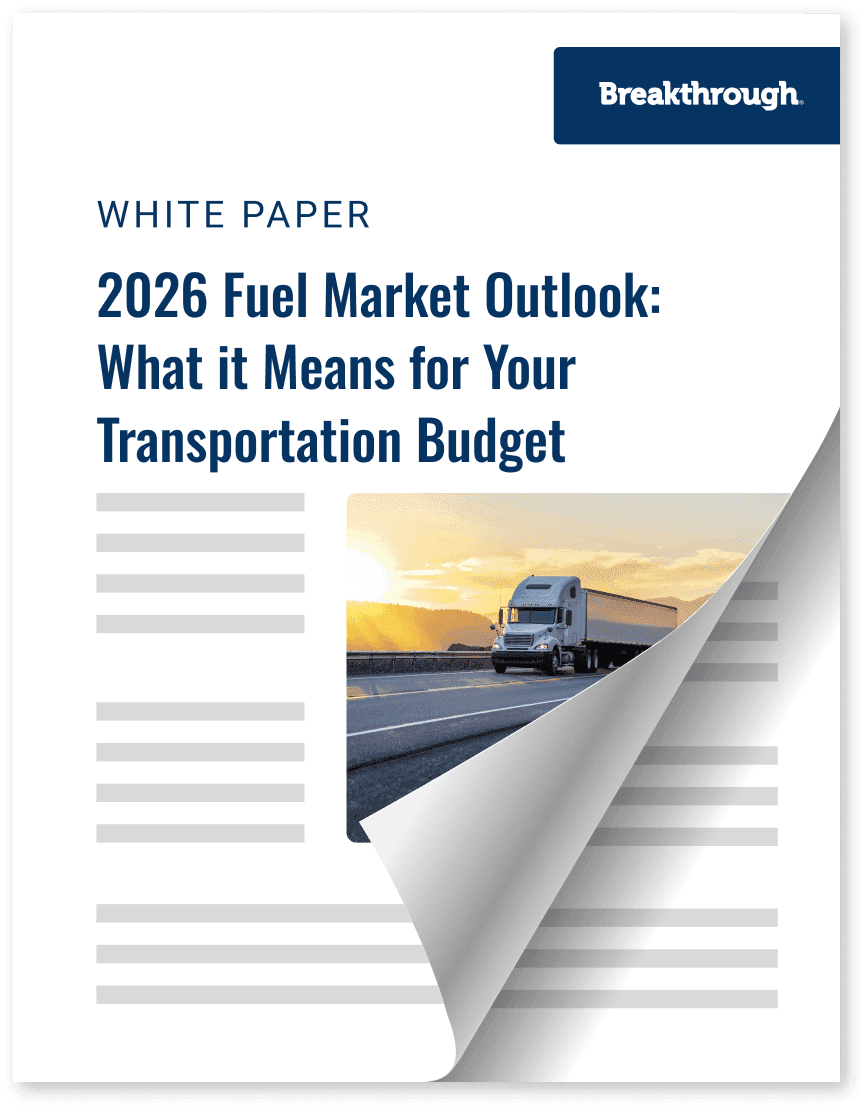2026 Fuel Market Outlook: What it Means for Your Transportation Budget

Trending
Top Posts
6 min read
August 1, 2017

Share:
Table of contents
Browse the table of contents to jump straight to the part you’re looking for
The cost of fuel is one of the largest items in transportation budgets, second only to labor. Paying for the fuel that moves your goods to market typically makes up 20% to 30% of the total cost, whether fuel prices are low or high.
You might assume that when fuel prices dip, you are saving money. It may even seem like a time when you don’t need to worry about the cost of diesel.
That’s not exactly true. While fuel prices may be cheaper, it doesn’t necessarily mean you are paying a fair price. The truth is, energy management becomes increasingly important in a down market, and you need the right partner to help determine an accurate fuel surcharge.
Breakthrough’s Vice President of Advisory Services, Daniel Cullen, helps explain four examples of why energy management is even more crucial when fuel prices are dropping.
It’s essential to understand that traditional fuel surcharge programs are based on the DOE Index, which generates a weekly average of retail diesel fuel prices. Breakthrough revolutionized the industry by doing things differently.
One of the fundamental advantages of a Breakthrough Fuel Recovery program is that shippers pay for fuel based on the wholesale price of diesel, not retail. This price point is where well-managed carriers procure fuel, and reimbursement at this level makes a difference no matter where the market is. However, the variance is even greater when diesel prices are falling because wholesale and retail prices react differently to change.
Cullen often uses the analogy of a stone and a feather to explain these reactions. In a down-market, the wholesale or market price sinks like a stone while retail diesel prices float down slowly, like a feather.
“Whenever fuel prices are moving down, the market cost of fuel, which is the price point where carriers are purchasing, is always going to be more sensitive than the DOE Index or any retail-based price,” Cullen explains.
Cullen says, in a steady market, the common spread between wholesale and retail fuel prices is around 30-cents per gallon. When prices drop suddenly, that number can change dramatically.
“In early 2015, when there was a sharp decline in oil prices, there was a difference between wholesale and retail of 97-cents per gallon of diesel on average,” Cullen says. “Granted, those price differences don’t always last a long time. However, if you’re a large shipper and you’re buying millions of gallons of fuel a year, that’s a lot of money.”
It’s worth noting that during the first half of 2017, the market for oil remained relatively steady and the difference between wholesale and retail diesel was around 40-cents per gallon on a national basis.
Human psychology plays a significant role in how retail fuel prices are set. Cullen uses consumer gasoline purchasing habits as an example.
When the cost of filling up the gas tank is lower, people are more likely to use Premium gasoline, even though they aren’t driving vehicles requiring that kind of fuel. Those misinformed consumers simply feel like they can afford a more expensive option.
On the other hand, when fuel prices are high, gas stations become more competitive on price as drivers become more aware of the cost and keep an eye out for the location in town selling gas for a few cents less.
The same sort of psychology comes into play for diesel fuel used in shipping and transportation. When diesel prices drop, retailers of fuel see an opportunity to increase their profit margins. While prices at the pump are certainly lower, shippers are likely paying more than they should for fuel. Yet, many simply assume they’re getting a better deal since diesel prices are falling.
“All of this is only a concern to shippers who are buying at a retail price point, which is to say on the DOE Index,” Cullen reminds us. “If you’re buying at the cost price, then you don’t have to worry at all about retail psychology.”
Tax increases on fuel operate on a somewhat similar psychology. Cullen says tax changes at the state level happen more frequently and are more substantial in a down market.
“When fuel prices are high, there is very little political will to raise fuel taxes,” he says. “That’s one of the last things you want to do if you’re looking to get re-elected. When fuel prices are falling, state governments have the opposite opportunity. If you increase fuel taxes while prices are moving down, the price increase from taxation is absorbed rather quickly.”
Keep in mind, the DOE Index does not consider tax discrepancies in the equation, much less ongoing changes by individual states. With the DOE Index, taxes are based on an average retail sample.
“You just pay one number for every state in the country,” says Cullen. “But, if you manage fuel at the appropriate level, you are capturing value where tax discrepancies benefit you, and you’re keeping carriers whole in regions where taxes are going up.”
He adds that certain states base fuel tax rates on a certain percentage rather than a flat rate per gallon. That means shippers relying on the DOE Index could miss out on potential savings in those states when there’s a down market.
Failing to account for tax changes and other activity results in distortion and increased costs to a shipper’s bottom line.
Taxes aren’t the only component that drive variation in diesel prices from state to state. While overall fuel prices may be lower, certain regions will see spikes due to unforeseen events that impact production.
“Even in a down market, you could have a major oil refinery taken offline and that’s going to increase diesel prices 10 or 15-cents a gallon overnight in a particular market,” Cullen says.
“You could have a pipeline explode or a hurricane might take infrastructure down. Any of these events, which you can’t predict, could happen in any market, down or up. If you’re not accounting for those geographical differences daily, you’re going to be vulnerable to misinformation and distortion.”
Cullen recalls one situation in which there was an explosion along a major U.S. pipeline. Shippers were told that the fuel surcharge needed to increase as a result. Few questioned the move because it was a major story in the news.
“The important nuance, which was overlooked, was that the explosion happened on a gasoline pipeline. The diesel pipeline was fine and there was no measurable impact to the diesel supply whatsoever.”
That’s the perfect example of why shippers need industry experts and reliable systems to help them manage transportation energy needs and ensure they are being treated fairly.
Breakthrough’s mission is to remove distortion and bring transparency to transportation, helping shippers reduce costs, consumption, and emissions from their supply chains. We do that by focusing on actuals not averages when determining the price you pay with a Fuel Recovery program.
We also provide valuable information to our clients through exclusive publications, webinars, and collaborative events such as Mercury Group. All of this helps companies make informed decisions to improve supply chain efficiency.
Want to find out how much you could be saving with Breakthrough? Contact us to learn more.

6 min read
November 20, 2025
Understand the impact of Ukrainian drone strikes on Russian refineries. Learn why diesel prices are volatile and how to protect your budget from market shocks.
Read more
7 min read
November 11, 2025
Discover how fuel management systems cut costs, track emissions, and improve reimbursement accuracy for modern freight operations.
Read more
6 min read
November 10, 2025
Explore how the proposed Union Pacific–Norfolk Southern merger could reshape rail in the U.S. Learn impacts on competition, pricing, and service.
Read more